Street Orchards for Community Security
© Brad Lancaster, www.HarvestingRainwater.com
Drops in a Bucket Blog
My view of public streets was radically changed when I heard ecovillage designer Max Lindigger tell the story of an insightful walk he took with his grandfather. “Look there,” said his grandfather, pointing to condominiums being built on the once-forested slopes above his village in the Swiss Alps. “That’s where we grew and gathered food during the war. The forests were common land, a reserve of community resources. What commons remain? Where will we grow and gather our food in the next catastrophe?”
I then looked at my Sonoran desert city of Tucson, Arizona, and asked myself, “Where are my community’s forests, our commons? Where would we get our food in times of need?”
Over 450 native food plants grow wild in the intact areas of the Sonoran Desert.1 The velvet mesquite tree is one of the keystone species, producing a reliable crop of diabetes-deterring, naturally sweet, protein- and carbohydrate-rich seeds and seedpods in both wet years and drought.2 Thus it used to be a staple of the indigenous people’s diets. Yet the vast majority of these trees and the greater ecosystem have been bulldozed within my city to be replaced with a hot and inhospitable pavement of impermeable streets, parking lots and buildings or landscapes of water-hungry exotic plants dependent upon irrigation from dwindling water supplies. The pavement drains much of our scant 12 inches (305 mm) of average annual rainfall out of the community through runoff and evaporation. Yet, this pavement is also the excessively long corridor by which most of our food arrives. According to the WorldWatch Institute, the average American meal travels 1,500 to 2,500 miles (2,400 to 4,000 km) from the farm to the table.3 If oil supplies that fuel semi-trailers disappeared we’d be without food. If the power that fuels our well pumps went out, we’d be out of water. We are creating the conditions for catastrophe.
But that can change by turning “wastes” into resources, and turning challenges into opportunity. The majority of public land—our commons—in the urban setting is our public streets and adjoining right-of-ways. All too often there is little or no vegetation there, let alone a forest. But the resources (soil, local-nursery- and backyard-grown native plants, rainwater runoff, and people) to grow a forest, or at least regionally appropriate orchards, are there (figs. 24 and 25.)
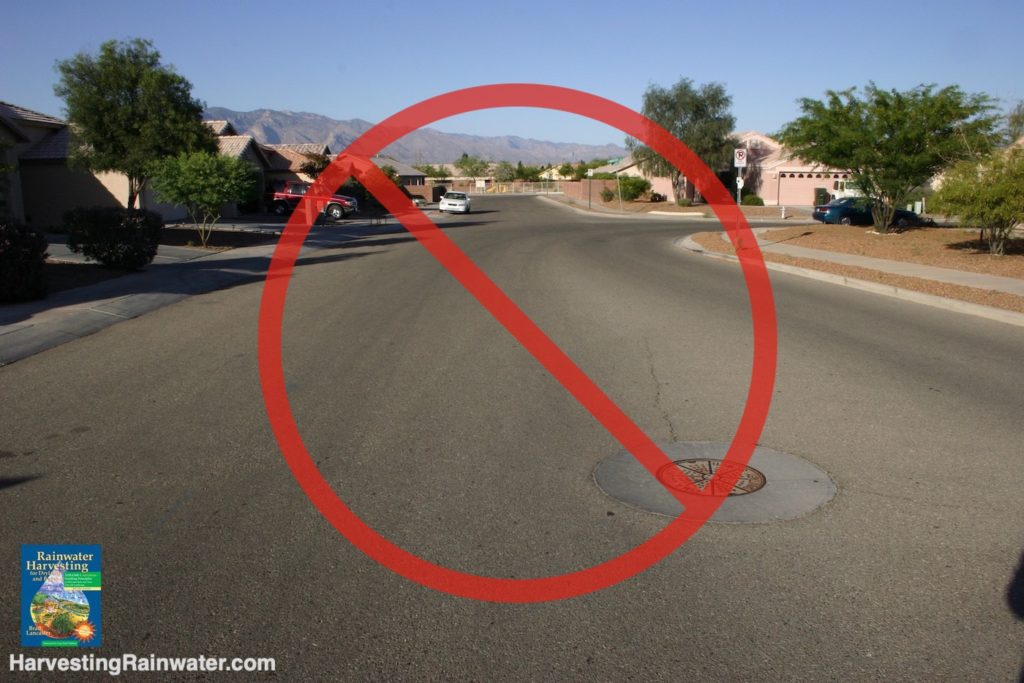
An excessively wide, exposed, solar-oven-like residential street in Tucson, Arizona absorbs the sun’s heat during the day like a battery, then radiates it out at night.
This local warming effect has raised summer temperatures in Tucson by 6°F (3°C) since the 1940s, which contributes to global warming since the higher temperatures result in people using air conditioners more, which are powered by electricity generated through the burning of coal.
Note that no shade trees are planted in the public right-of-way along the street, leaving street and sidewalk baked. All runoff is drained off site leaving the development dehydrated.
Reproduced with permission from “Rainwater Harvesting for Drylands and Beyond, Volume 1″
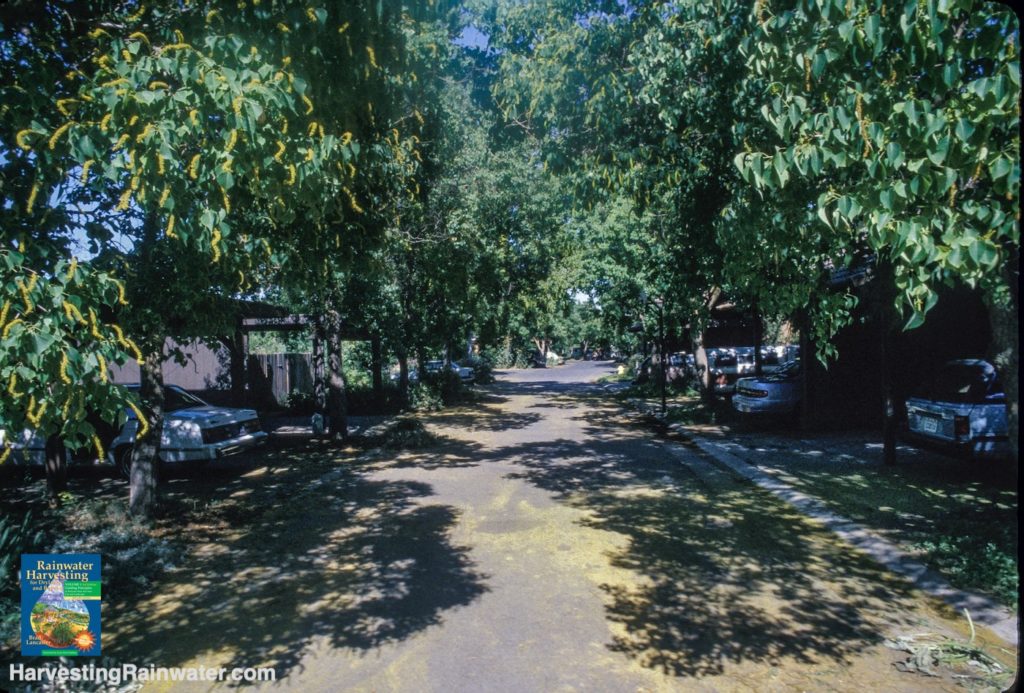
A narrow, mature tree-lined, and shaded street in Village Homes, Davis, California. T
his local cooling effect from shading has resulted in summer temperatures dropping 10°F (5.5°C), which reduces global warming since lower temperatures result in people using air conditioners less, which are powered by electricity generated through the burning of coal.
Note that runoff from the street is directed to the trees that shade the street; beneficially hydrating the site, while also reducing downstream flooding. The trees are deciduous, so they drop their leaves and let more sun in during winter.
Reproduced with permission from “Rainwater Harvesting for Drylands and Beyond, Volume 1″
Once established, native food plants can survive on our natural rainfall patterns without irrigation. With harvested rainfall these plants can thrive. The vast majority of Tucson’s stormwater runoff is currently diverted straight from roofs, driveways, patios, parking lots, and convex landscapes to public streets that flood to resemble rivers; the runoff then exits via storm drains (fig. 26). If we recognize runoff as an asset rather than a liability, we can harvest it before it runs down the drain, and with it, sustainably grow native food forests on public rights-of-way along the neighborhood streets that act like ephemerally flowing riverbeds, and within public parks and on private property (fig. 27). This also greatly reduces potential flooding of downstream areas, while improving stormwater quality.
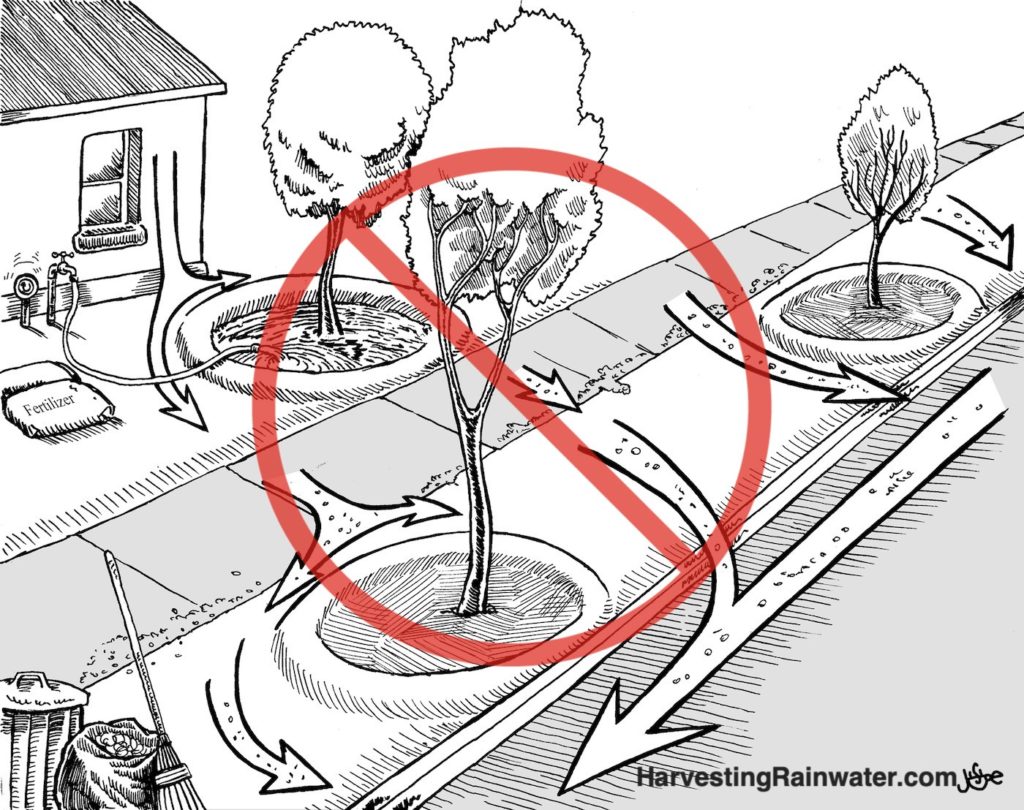
Arrows denote water flow.
Reproduced with permission from “Rainwater Harvesting for Drylands and Beyond, Volume 1″
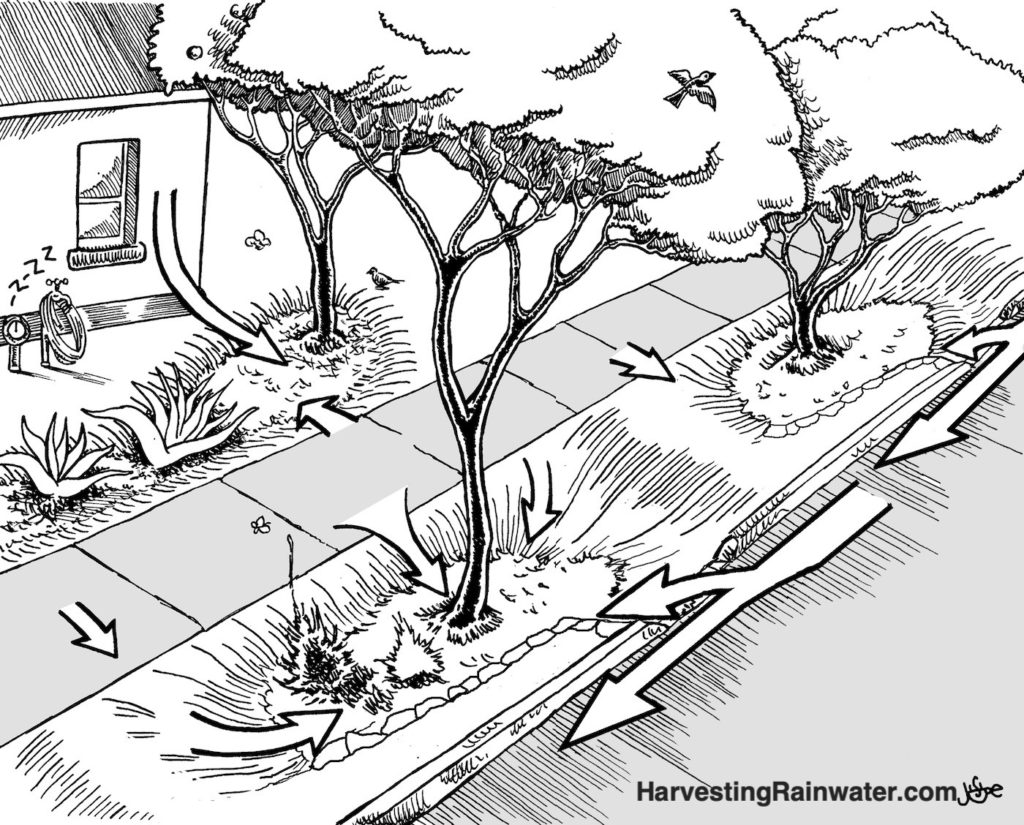
Reproduced with permission from “Rainwater Harvesting for Drylands and Beyond, Volume 1″
That’s a big part of the idea behind a collaborative effort in my hometown called Neighborhood Harvesters, which strives to promote, celebrate, and enhance local food production and security by planting indigenous, food-bearing shade trees in water-harvesting earthworks, and then showing folks how to harvest and process the bounty. Annual events include neighborhood tree plantings, milling events with Desert Harvesters that grind mesquite seedpods harvested from neighborhood trees into delicious flour, and native/local food feasts.
Planting Community Roots
We encourage neighborhood activists to organize tree plantings in their communities, emphasizing hardy, food-producing shade trees native to the Tucson Basin. We provide a list of the recommended trees, their description, and some of their uses on our website. These trees are the best for the area, since they have adapted over millennia to our local climate and soils, and coevolved with the native wildlife.
Neighbors can purchase these trees in 5-gallon sizes for just $8 each thanks to generous subsidies from Tucson Electric Power Company and the local program Trees for Tucson. (Tree prices in 2022 are $30 each). A community tree-planting day is set for each neighborhood to distribute their trees, and it’s kicked off with a free workshop on how to plant them in water harvesting earthworks. Volunteer crews of neighborhood residents then set out to plant trees along their streets, sidewalks, and in private yards. Within hours of planting the neighborhood feels changed for the better — more neighbors know each other, the trees show the care and commitment people have for their community, and water-harvesting earthworks can be observed by all (fig. 28). Within six years of planting the trees are full and beautiful, regularly blooming with seasonal color. Neighborhoods find that as native habitat grows back within the urban core, exotic pigeon populations start to be replaced by native bird life such as cardinals, flycatchers, cactus wrens, hummingbirds, curve-billed thrashers, white-winged doves, Gambel’s quail, and Gila woodpeckers. The community’s sense of place becomes reconnected to the flora and fauna of the local ecosystem, which is becoming reestablished right outside their homes. Within eight to ten years of planting, the tree-shaded sections of the neighborhood are noticeably cooler than unplanted areas (compare figs. 29 and 30). This confirms what studies have shown — shade trees growing along streets can cool the summer temperatures of urban neighborhoods by 10°F (5.5°C) if the canopy shades enough of the hardscape.4 This can greatly reduce a community’s power consumption since less power is then needed to cool buildings mechanically. Plant a tree and you plant a living air conditioner.
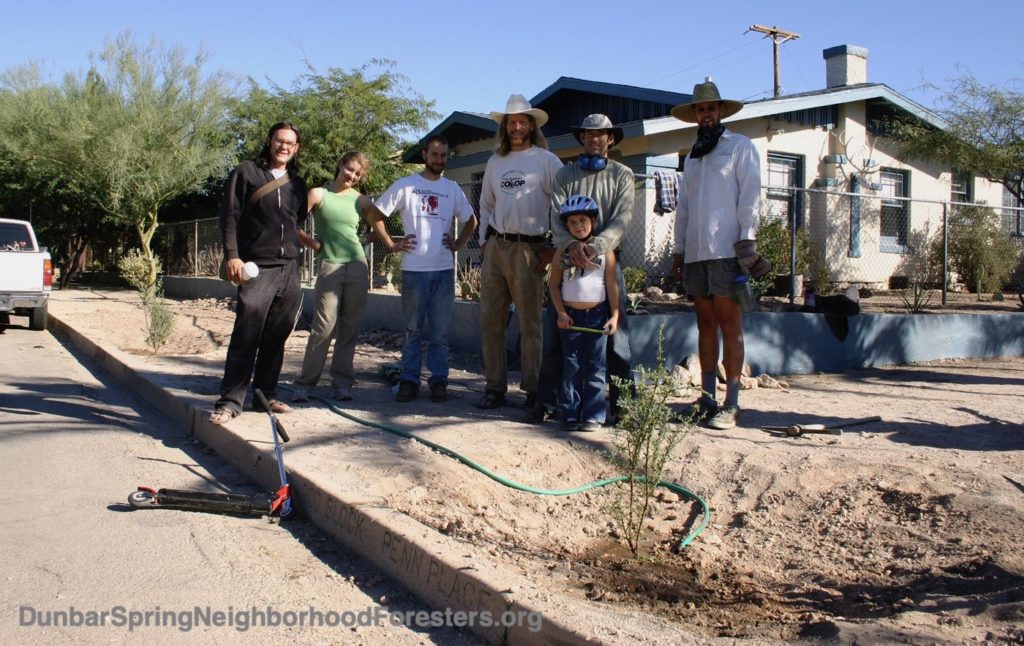
Neighbors help each other plant trees, and thereby get to know one another and create a more dynamic, close-knit community.
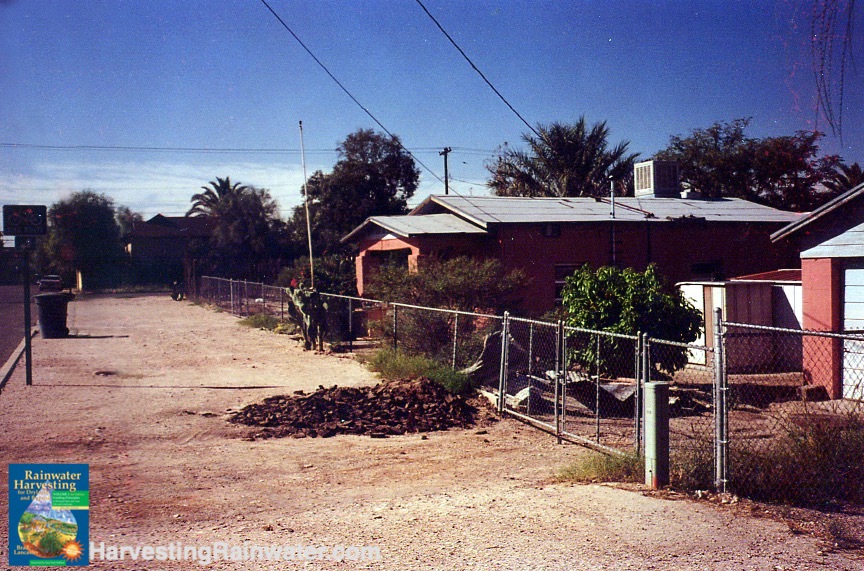
Public right-of-way adjoining property, with asphalt driveway freshly removed. 1994.
Photo: Brad Lancaster
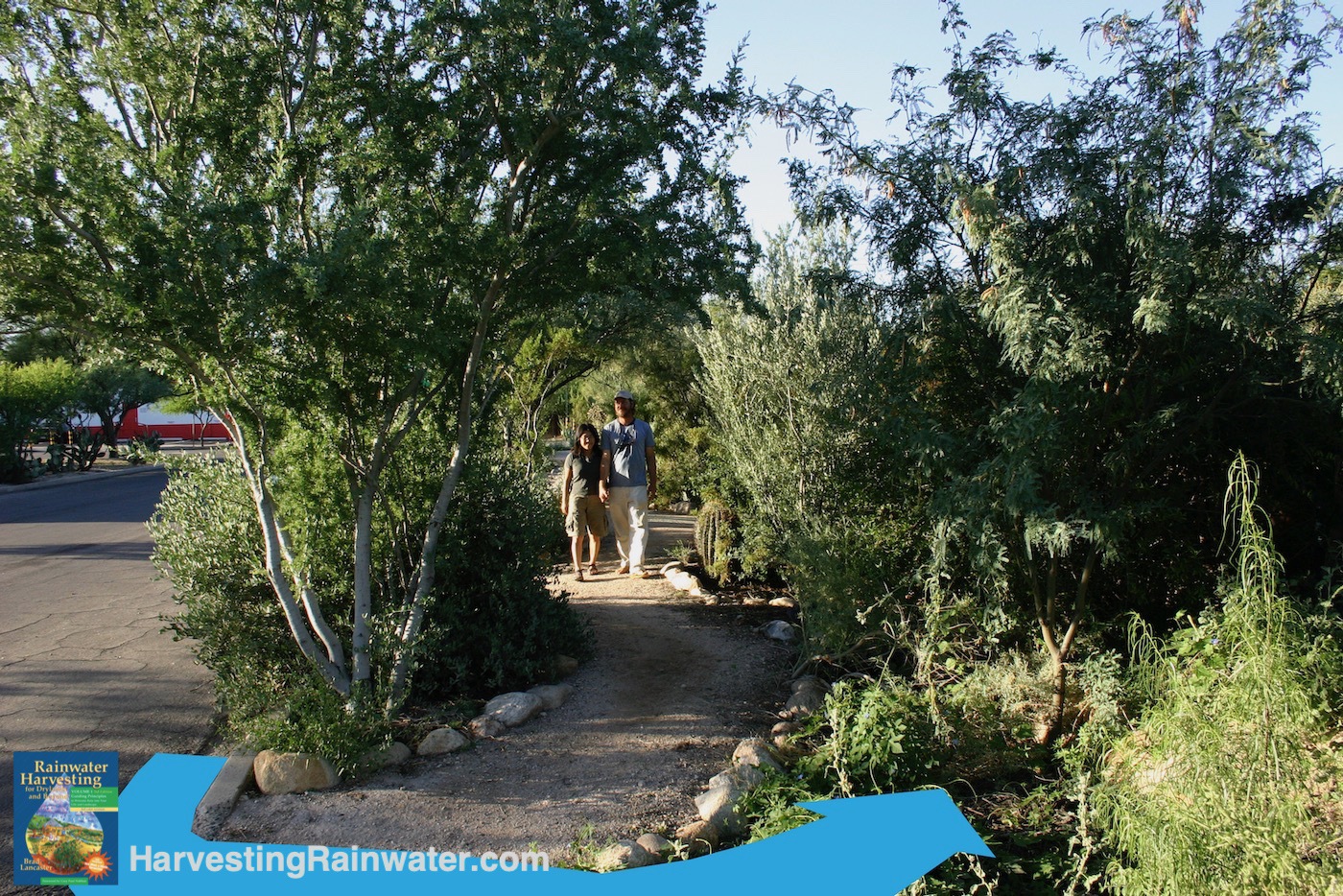
Same section of Dunbar/Spring right-of-way as fig. 29.
Used with permission from “Rainwater Harvesting for Drylands and Beyond”
Additional indigenous food trees in the Tucson area include foothills palo verde (Cercidium microphyllum) and blue palo verde (Cercidium floridum), which produce delicious flowers and barley-flavored seeds, and desert ironwood (Olneya tesota), which produces peanut-flavored seeds. Many native plants also have medicinal value and provide craft materials such as dyes, wood, glues, fiber, and more. Native food trees in other regions might include oak, pinyon pine, sugar maple, or date palm.
The Harvest
Harvesting advice is given on our website, and harvesting workshops are given in areas of the community where the trees have been planted. The harvest extends well beyond the picking of fruit and seed. We also try to teach folks to appreciate the value of harvesting the local resources that will support and enhance the trees — such as rainwater runoff and mulch. The implementation of rainwater-harvesting cisterns is encouraged to augment water-harvesting earthworks with captured roof-runoff, and enhanced water-harvesting earthworks are utilized along streets to use street runoff to irrigate passively the trees planted along the streets. This simultaneously enhances local water resources while creating a beautiful, multipurpose greenfrastructure of flood-controlling landscapes. For more information on these strategies, please see my books Rainwater Harvesting for Drylands and Beyond, Volumes 1 and 2 at www.HarvestingRainwater.com.
In addition to harvesting runoff, the basin-like earthworks passively harvest mulch in the form of leaf and fruit drop. The mulch increases the rate at which rainfall is absorbed into the soil, minimizes water loss to evaporation, and naturally fertilizes the soil. Rather than strip-mining nutrients from the trees and soil by raking away fallen leaves and fruit drop (fig. 31), we encourage folks to let this organic matter collect within the basins around the trees to decompose naturally and cycle back into the vegetation and soil (fig. 32). Prunings are cut up into 4-inch (10-cm) long sections and laid beneath the trees from which they were cut. Harvest your leaf drop and prunings, and the nutrient loop becomes regenerative. Trees grow taller and stronger.
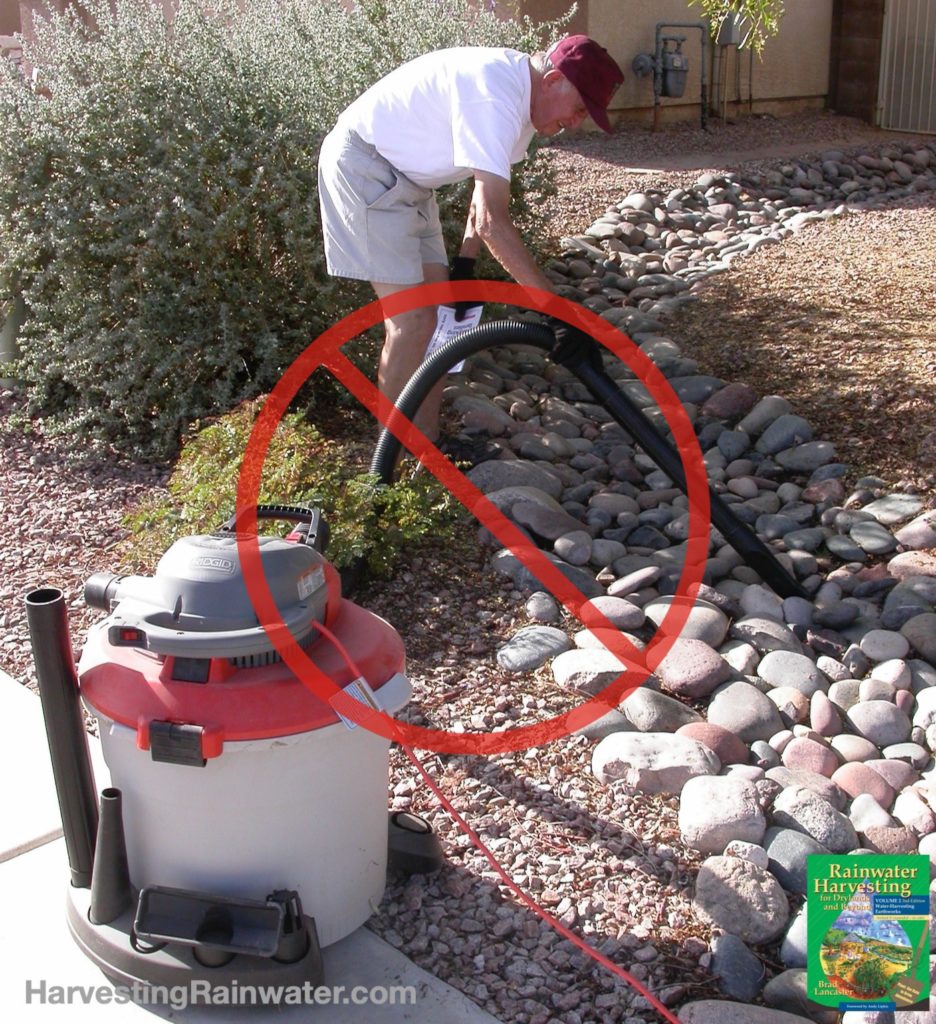
Photo credit: Jenny Leis.
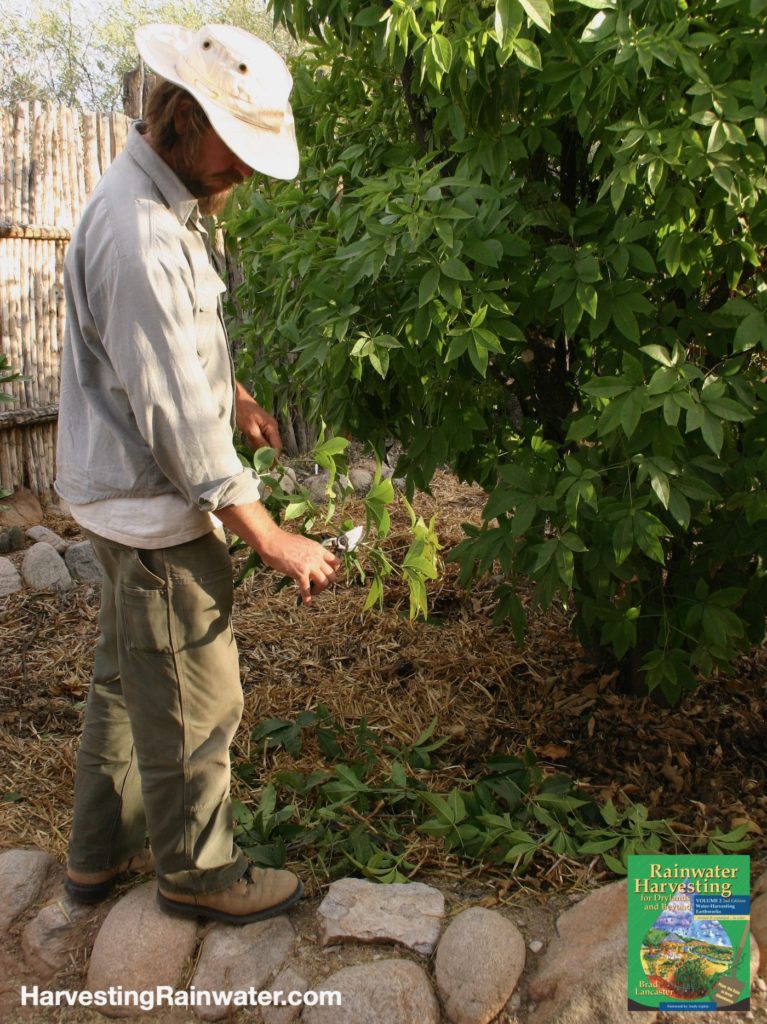
Photo credit: Brad Lancaster
Milling and Enjoying Mesquite
We live in a society that is often short on time and in search of convenience. Traditional means of grinding mesquite pods and processing other wild foods often demand more time than busy folks are willing to give up. So we sought to speed up the process and make it fun. Thanks to a $4,900 PRO Neighborhoods grant we were able to purchase a farm-scale hammermill and mount it to a trailer to make it mobile. We take the mill to various public, community milling events to which folks can conveniently bring their harvested mesquite pods (fig. 33). The hammermill can grind 5 gallons of whole mesquite pods into 1 gallon of finely textured, naturally sweet flour in just 5 minutes. Traditionally this would’ve taken hours (fig. 34).
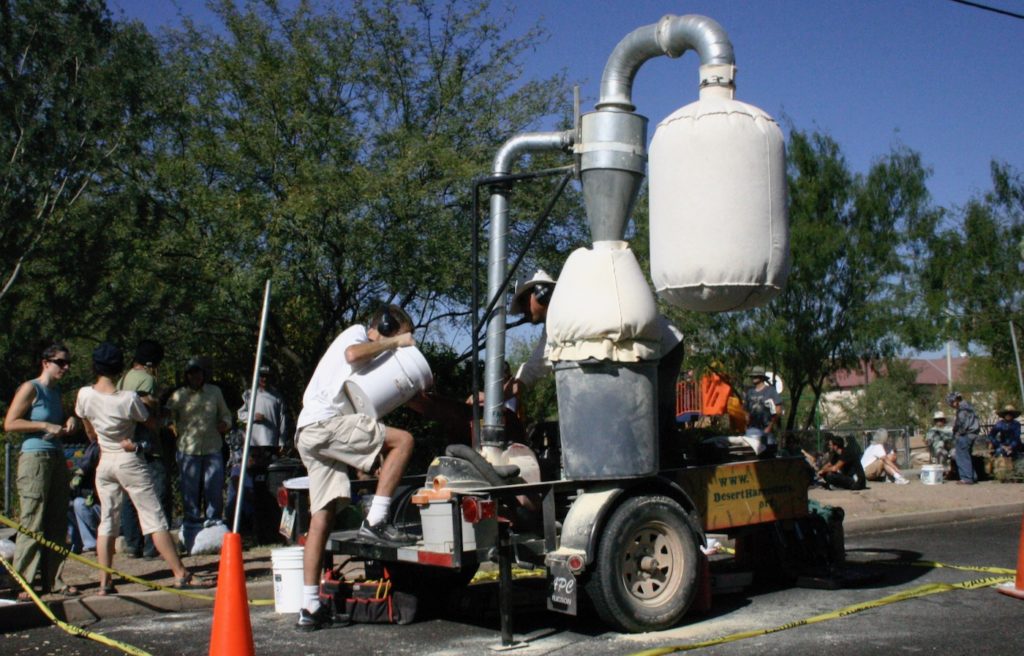
Photo credit: Brad Lancaster
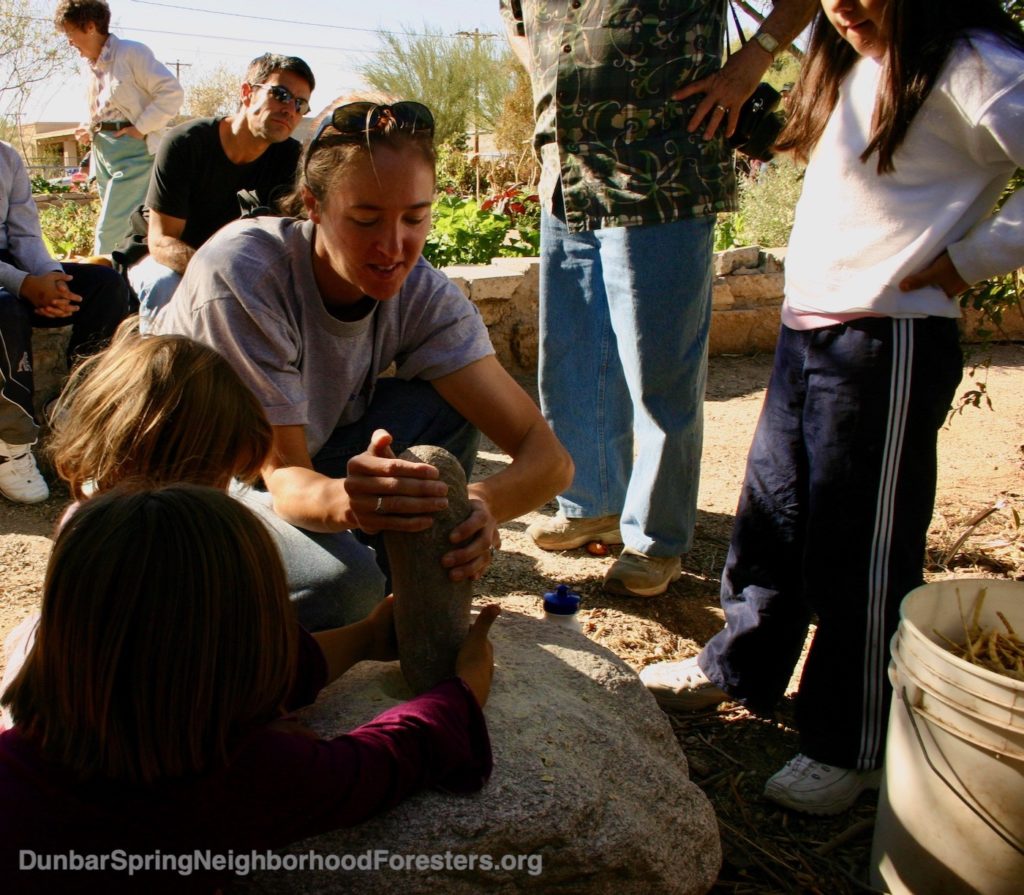
Photo: Brad Lancaster
The milling events are typically held in conjunction with local farmers’ markets or mesquite pancake feasts to enhance the diversity of available foods and to expose folks to the wonderful flavors and potential abundance of locally grown foods. The events are organized in October and November at community gardens, the community food bank, and community centers, to correspond with the late summer garden harvest and the end of the mesquite pod harvest. Mesquite pancakes served with prickly pear and saguaro syrups or backyard honey “plant the seeds” of the native foods’ delicious tastes and potential within the minds and palates of the hungry public (fig. 35). The sale of, and feasting on, local garden produce like corn, squash, tomatoes, and tepary beans, and cultural foods like tamales, sweet potato pie, and pickled cholla buds are encouraged. Local musicians play as folks eat and the hammermill is fired up to grind the mesquite pods brought by community members who harvested over the summer. Flour goes home with the harvesters, and mesquite breads, cookies, and sauces are cooked up in their kitchens.
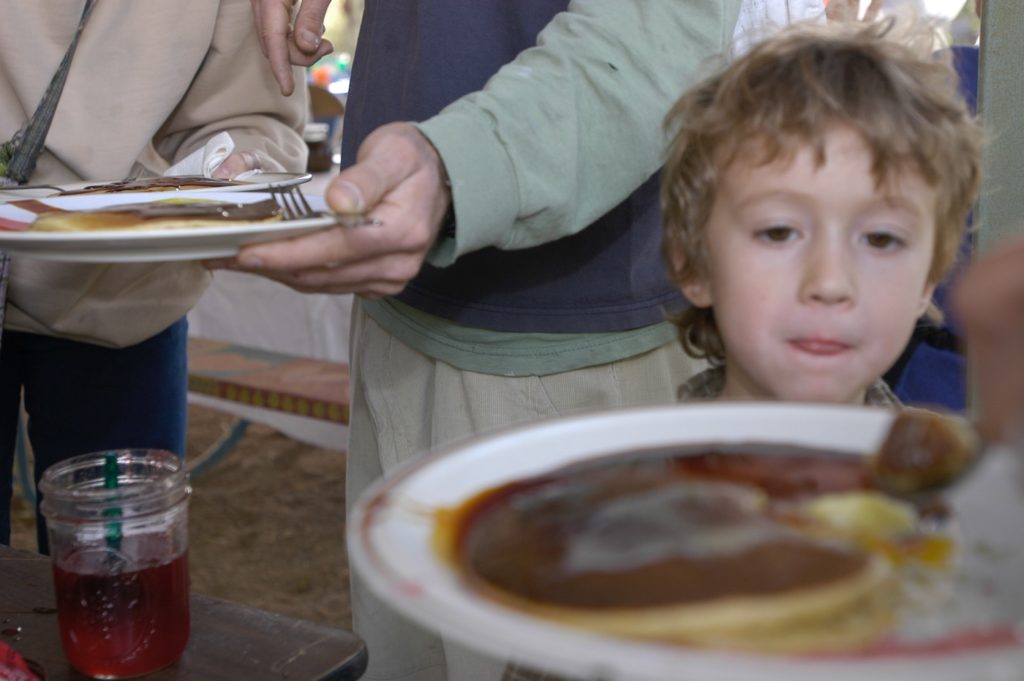
Photo credit: Josh Schachter
By planting, harvesting, and sharing the produce of the native ecosystem and backyard gardens these foods become sustainable parts of our daily experience, community/cultural identity, and food security. Many of these plants, particularly the natives, do not need imported resources to grow. By incorporating such strategies as water harvesting, passive mulching, and strategic planting (such as along streets or on the east and west sides of buildings), local resources are enhanced, wildlife can prosper, neighborhoods are beautified, and communities are made more liveable. By sharing and celebrating community efforts and resources knowledge is spread, the value and appreciation of local resources grows, and community ties and investment build. All of this is an integrated means of designing to thwart catastrophe, while enhancing our lives now. And the benefits steadily grow both with the trees, the relationships we have initiated with our neighbors, and a deeper connection to place and the resources that sustain it.
Brad Lancaster is a permaculture teacher, designer, consultant, and activist living in Tucson, Arizona. He is co-founder and organizer of the Dunbar/Spring Neighborhood Foresters. He was a co-founder of Desert Harvesters in 2003 (and resigned in 2020). In addition, he is the author of the award-winning books Rainwater Harvesting for Drylands and Beyond, Volumes 1 and 2 at www.HarvestingRainwater.com.
The potential of harvested street runoff
For every inch of rainfall
- A 10-foot wide paved street will drain 27,800 gallons of runoff per mile
- A 20-foot wide paved street will drain 55,700 gallons of runoff per mile
- A 30-foot wide paved street will drain 83,500 gallons of runoff per mile
For every 100 mm of rainfall
- A 3-m wide paved street will drain 300,000 liters of runoff per mile
- A 6-m wide paved street will drain 600,000 liters of runoff per mile
- A 9-m wide paved street will drain 900,000 liters of runoff per mile
References:
1. Hodgson, Wendy, Food Plants of the Sonoran Desert, University of Arizona Press, 2001.
2. Niethammer, Carolyn J., The Tumbleweed Gourmet – Cooking with Wild Southwestern Plants, University of Arizona Press, 1987.
3. Halweil, Brian, Home Grown – The Case For Local Food in a Global Market, WorldWatch Paper 163, WorldWatch Institute, 2002.
4. Hammond, Johnathan, Marshall Hunt, Richard Cramer, and Lauren Neubauer, A Strategy for Energy Conservation – Proposed Energy Conservation and Solar Utilization Ordinance for the City of Davis, California, City of Davis, CA Energy Conservation Ordinance Project, 1974.
5. Lancaster, Brad. Rainwater Harvesting for Drylands and Beyond, Volume 2, 2nd Edition: Water-Harvesting Earthworks, Rainsource Press, 2020.
See the new, full-color, revised editions of Brad’s award-winning books
– available a deep discount, direct from Brad:

Volume 1

